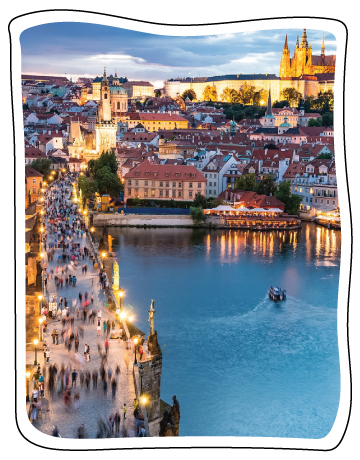Friendly disclaimer: We want to be as accurate as possible, but given these challenging times, we urge you to recheck that the venues are open and experiences available when you decide to travel.
A couple of decades ago Prague was quite the outlier on a traveller’s list of Europe. It’s now one of the most loved cities in the world, a place that people keep going back to for more. And for good reason. As you drive into Praha or Prague, from the Václav Havel Airport, you are greeted by the stuff of fairytales, complete with the tips and tops of spires. An apt welcome then, to ‘the city of a hundred spires’. The setting for this city of fabled beauty is magical. Perched on the banks of the languid Vltava River, its townscape of burgher houses, towers and palaces, is medieval urbanism at its best.
The importance of conserving its heritage past, from Romanesque, Gothic, Baroque, Renaissance and Art Nouveau architecture, has permeated into the realms of the other arts in the city.
Creators here have never limited themselves to the canvas. Art comes alive in every nook and corner of Prague. Here’s a look at some art experiences that form the fabric of not just the museums, but of the streets, cafes, monasteries, passageways and life, in this grand old city!
Café Slavia
On top of my list (well, on most traveller’s lists) is the Café Slavia or Kavarna Slavia. For me, it brings back memories of the views of the Vltava river and Charles Bridge at golden hour, through an absinthe-filled lens. It could have something to do with Viktor Oliva’s painting that hangs off the wall of the main room, titled The Absinthe Drinker. With its history and setting, the cafe, quite literally, has a prime spot amongst the iconic places in Prague.
With its many glass windows, chandeliers and mirrors, the experiences (culinary or otherwise) to be had here are varied. From straight-up coffees to hearty Czech fare of roast duck with potato dumplings and sauerkraut, beef guláš, and roast smoked pork with white cabbage and potato pancakes…and yes, to mind-bending absinthe-filled evenings. Come here for a slice of Prague’s local life, squally past, and a window to its intellectual side.
Café Louvre
This Art Nouveau style café is as lovely as it is rich with history that dates back to 1902. The cafe was nationalised by the communists in 1948 and was on a downward spiral until 1992 when the new owners took charge of it and restored it.
Go to the Café Louvre on Národní Třída (National Avenue) to soak in the atmosphere of a historical, grand café, as Franz Kafka and his friend Max Brod, Albert Einstein, T. G. Masaryk, and other illustrious names, once did. You can dial down here by reading the papers, sipping on coffee made in the Viennese tradition, and even having a turn at the billiards table.
Unravelog tip: When the clock strikes 5, head to Cafe Louvre to unwind with their traditional high tea, complete with little sandwiches, pastries and delectable desserts, served up with a selection of their fine black teas.
The passageway to contemporary Czech design
Here is a prime example of the unflinching support art and beauty get in this city. The National Bank of the Czech Republic decided to put its passageway to good use – by turning it into The Pasáž Českého Designu – or Passage of Czech Design, a pedestrian gallery dedicated to modern Czech design.
This shortcut (Prague is known for its most interesting connecting passageways) is an attempt to slow down the passage of time for passers-by. Stop, view, and keep yourself updated, with the latest in Czech design.
Address: Passage of Czech Design, Na Příkopě 24, 110 00 Praha 1- Nové Město
The most beautiful library in the world
There are a few times on my travels, where I’ve been open-mouthed in awe, as I was at this spectacular library. Frescoed ceilings, mahogany wood, ornate railings and pillars, extraordinary handmade Jesuit globes, the Baroque Library in Klementinum has all the ingredients in grand measure -to do justice to the title of ‘the most majestic library in the world’. A part of Jesuit University complex of buildings, the library houses foreign theological books, all the way from the early 17th century. If that doesn’t leave you dumbstruck, the frescos on the ceiling by Jan Hiebl will.
The subject for the frescoes are inspired by scientific as well as religious subjects. You can witness Hielbl’s method of trick painting here, which creates the illusion of the ceiling disappearing and the sunlight streaming into the room. Utterly sublime.
Unravelog tip: Climb the 172 stairs of the steep and winding staircase of the Astronomical Tower to a height of 52 meters, to get a 360-degree view of the old town and the iconic Prague skyline. One epic panoramic photo-op for sure.
Czech Museum of Cubism
The Czech Museum of Cubism, currently hosted at Josef Gočár’s ‘The house of the black Madonna’, was formerly a department store. The building was the first to be built in the vein of Cubist architecture in Prague. The museum exhibits Cubist works of art and design on two floors of the building. You can even try out the replicas of a few Cubist chairs here.
Don’t forget to swing by The Grand Café Orient, to marvel at the interiors of the world’s only surviving Cubist cafe.
Unravelog tip: Try the house speciality at the Grand Orient Cafe, their custard-filled choux pastry ‘věneček’ is a treat. In keeping with the Cubist theme, the pastry is shaped as a square instead of the usual circle.
Illusion Art Museum
Experience the unexpected at the Illusion Art Museum Prague (IAM Prague). A place of illusion and trick art, some works are historically significant, while others are contemporary. Marvel at the different cutting-edge styles of illusion art housed in this three-floor historically protected building. Interact with some of the exhibits and capture them in your photographs to take home some fun memories!
Unravelog tip: You can experience the unexpected from your armchairs now. The virtual tour of the IAM Prague museum is priced at Euro 2.99 and offers a virtual tour of the museum and of Prague’s iconic town square and astronomical clock. You can purchase tickets on their website.
Gothic convent with an art exhibit
Founded by St. Agnes of Bohemia, The Convent of St. Agnes is one of the oldest convents in Europe, besides being the big mama of Gothic architecture in the Czech Republic. The convent sits on the right bank of the river Vltava and was taken over by the National Gallery Prague in 1963. It now hosts a permanent exhibition of ‘Medieval Art in Bohemia and Central Europe 1200-1550’. It is home to a collection of over 200 works of paintings, sculptures and crafts from all over Central Europe, allowing viewers to closely observe the transformation of art over three centuries.
The church of St. Salvator in the same complex is a fabulous example of medieval architecture in the region.
Unravelog tip: If you are into spook, the convent (like so many places in the Czech Republic) has one to its name. Legend has it, the ghost of a nun who was murdered by her own father rambles around the convent at night, moaning in her blood-stained habit!
If you have more time in hand to soak in the charm of Prague some more, and to experience its many facets, check out the trip plan to unravel the city in 4 days!







